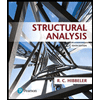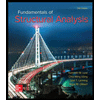QUESTION 1 (a) Sketch a bar element, a plane truss element, and a beam element. Label the axes, nodes and nodal degrees of freedom (dof). Identify the physical quantity of each dof. (b) Figure Q1(a) below shows a loaded cantilevered beam. The beam is made of a material with E = 200 GPa while the cross section of the beam is shown in Figure Q1(b).
QUESTION 1 (a) Sketch a bar element, a plane truss element, and a beam element. Label the axes, nodes and nodal degrees of freedom (dof). Identify the physical quantity of each dof. (b) Figure Q1(a) below shows a loaded cantilevered beam. The beam is made of a material with E = 200 GPa while the cross section of the beam is shown in Figure Q1(b).
Chapter2: Loads On Structures
Section: Chapter Questions
Problem 1P
Related questions
Question

Transcribed Image Text:QUESTION 1
(a) Sketch a bar element, a plane truss element, and a beam element. Label the axes, nodes and
nodal degrees of freedom (dof). Identify the physical quantity of each dof.
(b) Figure Q1(a) below shows a loaded cantilevered beam. The beam is made of a material
with E = 200 GPa while the cross section of the beam is shown in Figure Q1(b).
کسیس
2 kN/m
1
6 m
10 KN
(a)
2
4 m
8 kN
40 kN-m
Figure Q1
200 mm
(b)
400 mm

Transcribed Image Text:By using two (2) beam elements to model the beam, the nodal degrees of freedom are:
NODE 2
NODE 3
-0.014
-0.031
-0.004
-0.005
Deflection (m)
Rotation (radian)
NODE 1
0
0
At a section 3 m from the fixed end of the beam, calculate by using finite element method:
(i) the deflection;
(ii) the shear force;
(iii) the bending moment;
(iv) the maximum bending stress.
Expert Solution
This question has been solved!
Explore an expertly crafted, step-by-step solution for a thorough understanding of key concepts.
This is a popular solution!
Step 1: Introduce the problem statement
VIEWStep 2: State the characteristics of bar, truss and beam element
VIEWSolution
VIEWStep 3: Determine flexural rigidity of the beam
VIEWStep 4: Formulate element stiffness matrices
VIEWStep 5: Formulate global stiffness matrix
VIEWStep 6: Formulate load vector matrix
VIEWStep 7: Formulate displacement vector
VIEWStep 8: Determine joint displacement
VIEWStep 9: Determine support reactions
VIEWStep 10: Compute maximum bending stress
VIEWTrending now
This is a popular solution!
Step by step
Solved in 11 steps with 29 images

Knowledge Booster
Learn more about
Need a deep-dive on the concept behind this application? Look no further. Learn more about this topic, civil-engineering and related others by exploring similar questions and additional content below.Recommended textbooks for you


Structural Analysis (10th Edition)
Civil Engineering
ISBN:
9780134610672
Author:
Russell C. Hibbeler
Publisher:
PEARSON

Principles of Foundation Engineering (MindTap Cou…
Civil Engineering
ISBN:
9781337705028
Author:
Braja M. Das, Nagaratnam Sivakugan
Publisher:
Cengage Learning


Structural Analysis (10th Edition)
Civil Engineering
ISBN:
9780134610672
Author:
Russell C. Hibbeler
Publisher:
PEARSON

Principles of Foundation Engineering (MindTap Cou…
Civil Engineering
ISBN:
9781337705028
Author:
Braja M. Das, Nagaratnam Sivakugan
Publisher:
Cengage Learning

Fundamentals of Structural Analysis
Civil Engineering
ISBN:
9780073398006
Author:
Kenneth M. Leet Emeritus, Chia-Ming Uang, Joel Lanning
Publisher:
McGraw-Hill Education


Traffic and Highway Engineering
Civil Engineering
ISBN:
9781305156241
Author:
Garber, Nicholas J.
Publisher:
Cengage Learning